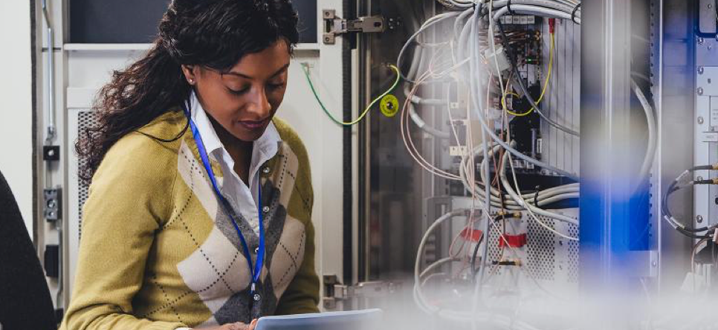29, October 2019
How to Protect Your Business from Cyber Attacks

This article originally appeared on IndustryWeek. Guest blog post by Traci Spencer, Grant Program Manager for TechSolve, Inc., the southwest regional partner of the Ohio MEP, part of the MEP National NetworkTM.
By
By:In part one of the MEP National Network five-part series on “Cybersecurity for Manufacturers,” we covered how to spot infrastructure weaknesses that open the doors to cyber attacks. Mitigating these threats takes more than a single anti-virus upgrade; it requires ongoing vigilance. But protecting your systems doesn’t have to be complicated. Here’s how to begin.
Limit Employee Access to Your Data & Information
Limiting access to your valuable company data reduces the chance for human error, which is the number-one information security threat. Employees should only have access to the systems and specific information they need to do their jobs.
If an employee leaves your company, or transfers to a different company location, take protective action immediately, including deleting passwords and accounts from all systems and collecting company ID badges and entry keys.
An ounce of access prevention can equal a pound of protection when it comes to limiting the impact of a disgruntled ex-employee.
Install Surge Protectors & Uninterruptible Power Supplies
Uninterruptible power supplies (UPS) can give you enough battery life and time to save your data in the event of a power disruption. Check to ensure the UPS type and size meets your company’s standards and requirements.
Every computer and networked device should be plugged into a UPS. For less-sensitive electronics and non-networked equipment, standard surge protectors should suffice. Be sure to test and replace each UPS and surge protector as recommended by the manufacturer.
Patch Your Operating Systems & Software Regularly
Every new app can open the door to a cyber attack if you don’t regularly patch and update all software on every device used by your employees.
Always check for updates when purchasing a new computer or installing a new software system. Be aware that software vendors are not required to provide security updates for unsupported products. For example, Microsoft® will stop supporting Windows 7 in January of 2020, so if you haven’t upgraded yet, now’s the time to do so.
Don’t delay downloading operating system updates. These updates often include new or enhanced security features.
Install & Activate Software and Hardware Firewalls
Firewalls can thwart malicious hackers and stop employees from browsing inappropriate websites. Install and update firewall systems on every employee computer, smartphone, and networked device.
Include off-site employees, even if you use a cloud service provider (CSP) or a virtual private network (VPN). You may also want to install an intrusion detection/prevention system (IDPS) to provide a greater level of protection.
Secure All Wireless Access Points & Networks
For secure wireless networking, use these router best practices:
- Change the administrative password on new devices
- Set the wireless access point so that it does not broadcast its service set identifier (SSID)
- Set your router to use WiFi Protected Access 2 (WPA-2), with the Advanced Encryption Standard (AES) for encryption
- Avoid using WEP (Wired-Equivalent Privacy).
If you provide wireless internet access to your customers or visitors, make sure it is separated from your business network.
Set up Web & Email Filters
Use email and web browser filters to deter hackers and prevent spam from clogging employee inboxes. You can also download “blacklist” services to block users from browsing risky websites that pose malware risks.
Caution your employees against visiting sites that are frequently associated with cybersecurity threats, such as pornographic websites or social media. This may seem like a no-brainer; but it only takes one employee to visit the wrong website to inadvertently download malwareonto your company systems.
Use Encryption for Sensitive Business Information
Use full-disk encryption to protect all your computers, tablets, and smartphones. Save a copy of your encryption password or key in a secure location separate from your stored backups.
Email recipients typically need the same encryption capability in order to decrypt. Never send the password or key in the same email as the encrypted document. Give it to them via phone or some other method.
Dispose of Old Computers & Media Safely
Before donating or trashing old computers, you need to wipe all valuable hard drive information. Delete any sensitive business or personal data on old CDs, flash drives, or other old media. Then destroy these items or take them to a company that will shred them for you. Destroy sensitive paper information with a crosscut shredder or an incinerator.
Train Your Employees
Cyber-vigilant employees are your best protection against information security threats.
Every employee should know:
- What business and personal use is permitted for emails
- How to treat business information at the office or at home
- What to do if a cybersecurity incident occurs
Train every new employee to protect valuable data and have them sign your information policy. Use newsletters and/or ongoing training to reinforce your culture of cybersecurity.
Now that we’ve covered the key steps to protect your valuable data and information, we’ll show you how to install mechanisms for detecting and recognizing a cyber attack in part three of our series on “Cybersecurity for Manufacturers” from the MEP National Network.
For more advice on cybersecurity best practices for manufacturers, contact the cybersecurity experts at your local MEP Center.